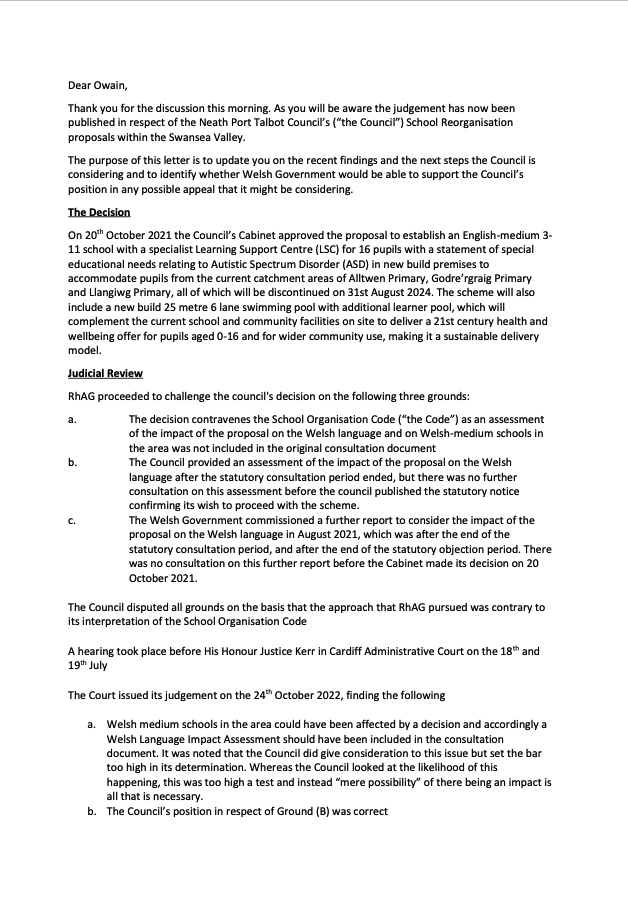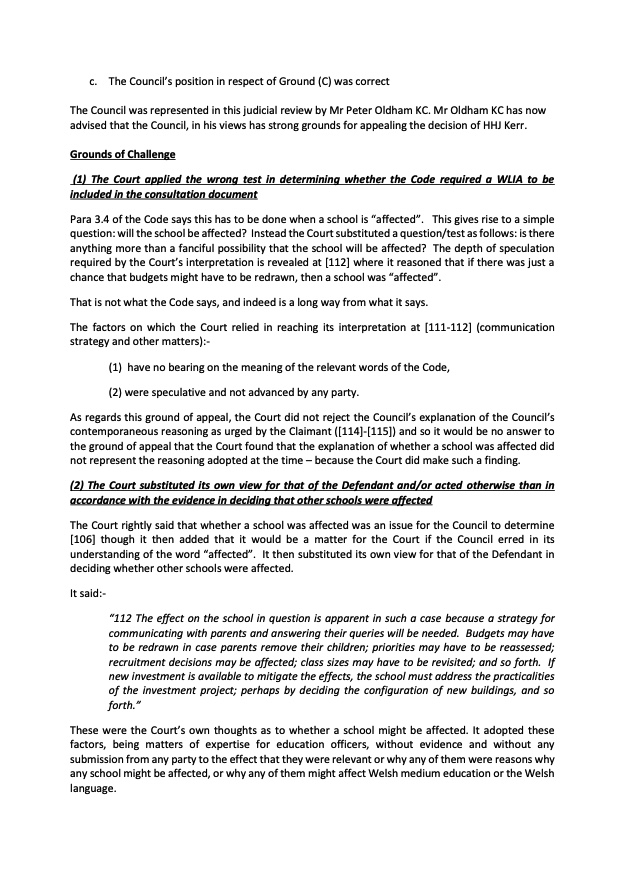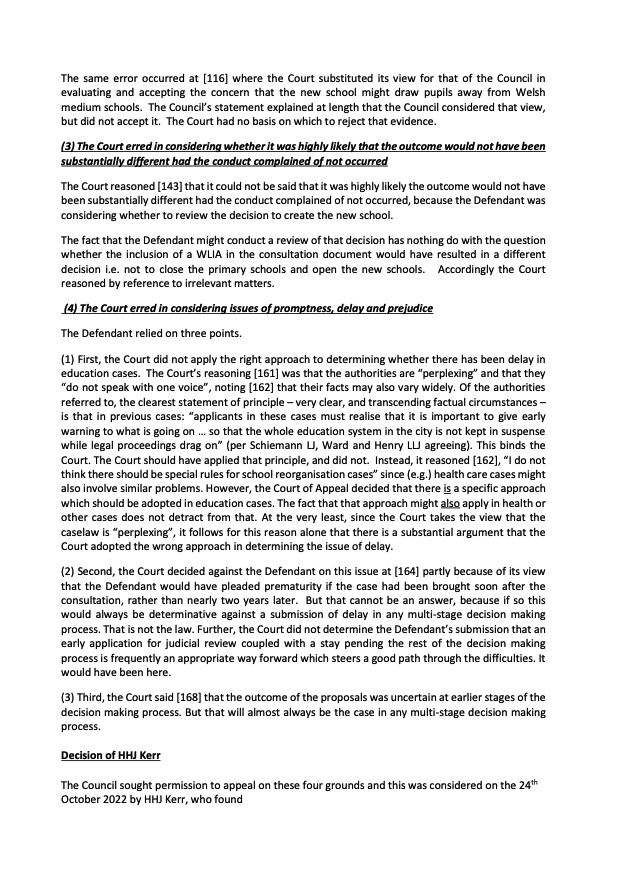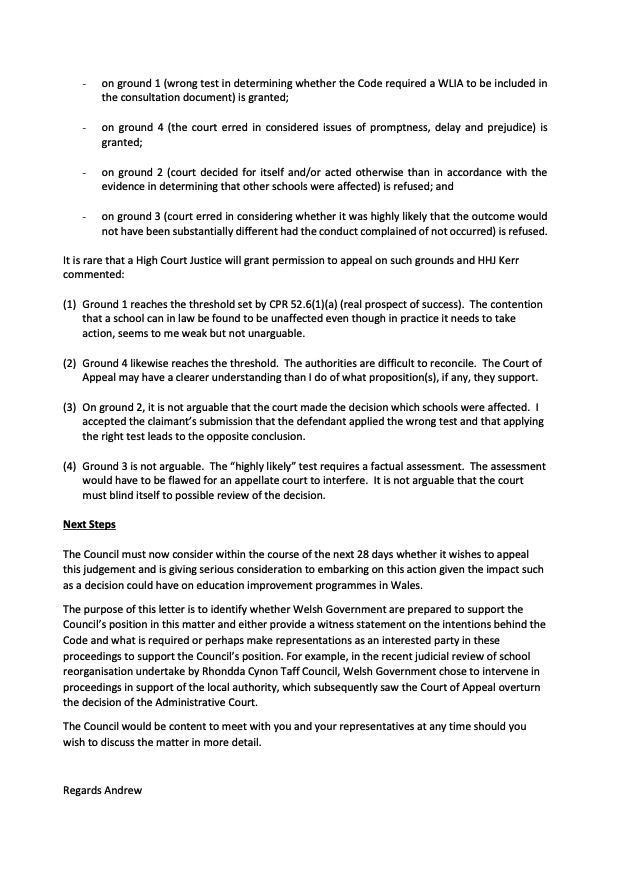c. The Council’s position in respect of Ground (C) was correct
The Council was represented in this judicial review by Mr Peter Oldham KC. Mr Oldham KC has now advised that the Council, in his views has strong grounds for appealing the decision of HHJ Kerr.
Grounds of Challenge
(1) The Court applied the wrong test in determining whether the Code required a WLIA to be included in the consultation document
Para 3.4 of the Code says this has to be done when a school is “affected”. This gives rise to a simple question: will the school be affected? Instead the Court substituted a question/test as follows: is there anything more than a fanciful possibility that the school will be affected? The depth of speculation required by the Court’s interpretation is revealed at [112] where it reasoned that if there was just a chance that budgets might have to be redrawn, then a school was “affected”.
That is not what the Code says, and indeed is a long way from what it says.
The factors on which the Court relied in reaching its interpretation at [111-112] (communication strategy and other matters):-
(1) have no bearing on the meaning of the relevant words of the Code,
(2) were speculative and not advanced by any party.
As regards this ground of appeal, the Court did not reject the Council’s explanation of the Council’s contemporaneous reasoning as urged by the Claimant ([114]-[115]) and so it would be no answer to the ground of appeal that the Court found that the explanation of whether a school was affected did not represent the reasoning adopted at the time – because the Court did make such a finding.
(2) The Court substituted its own view for that of the Defendant and/or acted otherwise than in accordance with the evidence in deciding that other schools were affected
The Court rightly said that whether a school was affected was an issue for the Council to determine [106] though it then added that it would be a matter for the Court if the Council erred in its understanding of the word “affected”. It then substituted its own view for that of the Defendant in deciding whether other schools were affected.
It said:-
These were the Court’s own thoughts as to whether a school might be affected. It adopted these factors, being matters of expertise for education officers, without evidence and without any submission from any party to the effect that they were relevant or why any of them were reasons why any school might be affected, or why any of them might affect Welsh medium education or the Welsh language.
“112 The effect on the school in question is apparent in such a case because a strategy for communicating with parents and answering their queries will be needed. Budgets may have to be redrawn in case parents remove their children; priorities may have to be reassessed; recruitment decisions may be affected; class sizes may have to be revisited; and so forth. If new investment is available to mitigate the effects, the school must address the practicalities of the investment project; perhaps by deciding the configuration of new buildings, and so forth.”
The same error occurred at [116] where the Court substituted its view for that of the Council in evaluating and accepting the concern that the new school might draw pupils away from Welsh medium schools. The Council’s statement explained at length that the Council considered that view, but did not accept it. The Court had no basis on which to reject that evidence.
(3) The Court erred in considering whether it was highly likely that the outcome would not have been substantially different had the conduct complained of not occurred
The Court reasoned [143] that it could not be said that it was highly likely the outcome would not have been substantially different had the conduct complained of not occurred, because the Defendant was considering whether to review the decision to create the new school.
The fact that the Defendant might conduct a review of that decision has nothing do with the question whether the inclusion of a WLIA in the consultation document would have resulted in a different decision i.e. not to close the primary schools and open the new schools. Accordingly the Court reasoned by reference to irrelevant matters.
(4) The Court erred in considering issues of promptness, delay and prejudice
The Defendant relied on three points.
(1) First, the Court did not apply the right approach to determining whether there has been delay in education cases. The Court’s reasoning [161] was that the authorities are “perplexing” and that they “do not speak with one voice”, noting [162] that their facts may also vary widely. Of the authorities referred to, the clearest statement of principle – very clear, and transcending factual circumstances – is that in previous cases: “applicants in these cases must realise that it is important to give early warning to what is going on … so that the whole education system in the city is not kept in suspense while legal proceedings drag on” (per Schiemann LJ, Ward and Henry LLJ agreeing). This binds the Court. The Court should have applied that principle, and did not. Instead, it reasoned [162], “I do not think there should be special rules for school reorganisation cases” since (e.g.) health care cases might also involve similar problems. However, the Court of Appeal decided that there is a specific approach which should be adopted in education cases. The fact that that approach might also apply in health or other cases does not detract from that. At the very least, since the Court takes the view that the caselaw is “perplexing”, it follows for this reason alone that there is a substantial argument that the Court adopted the wrong approach in determining the issue of delay.
(2) Second, the Court decided against the Defendant on this issue at [164] partly because of its view that the Defendant would have pleaded prematurity if the case had been brought soon after the consultation, rather than nearly two years later. But that cannot be an answer, because if so this would always be determinative against a submission of delay in any multi-stage decision making process. That is not the law. Further, the Court did not determine the Defendant’s submission that an early application for judicial review coupled with a stay pending the rest of the decision making process is frequently an appropriate way forward which steers a good path through the difficulties. It would have been here.
(3) Third, the Court said [168] that the outcome of the proposals was uncertain at earlier stages of the decision making process. But that will almost always be the case in any multi-stage decision making process.
Decision of HHJ Kerr
The Council sought permission to appeal on these four grounds and this was considered on the 24th October 2022 by HHJ Kerr, who found



